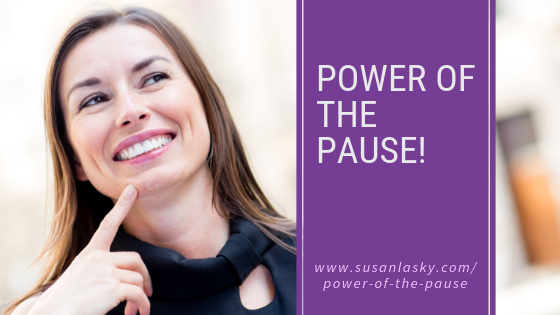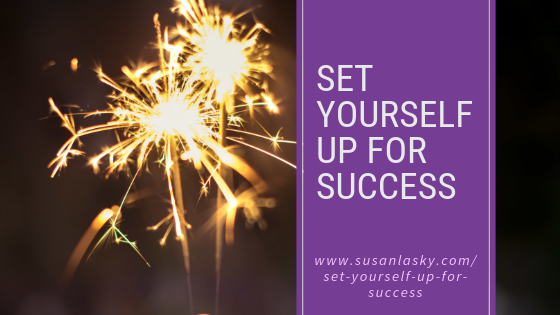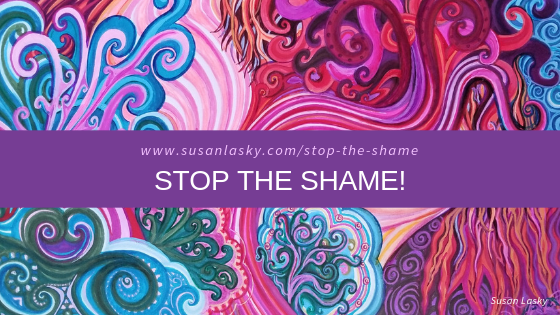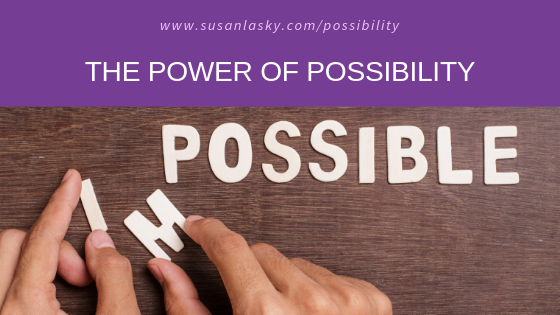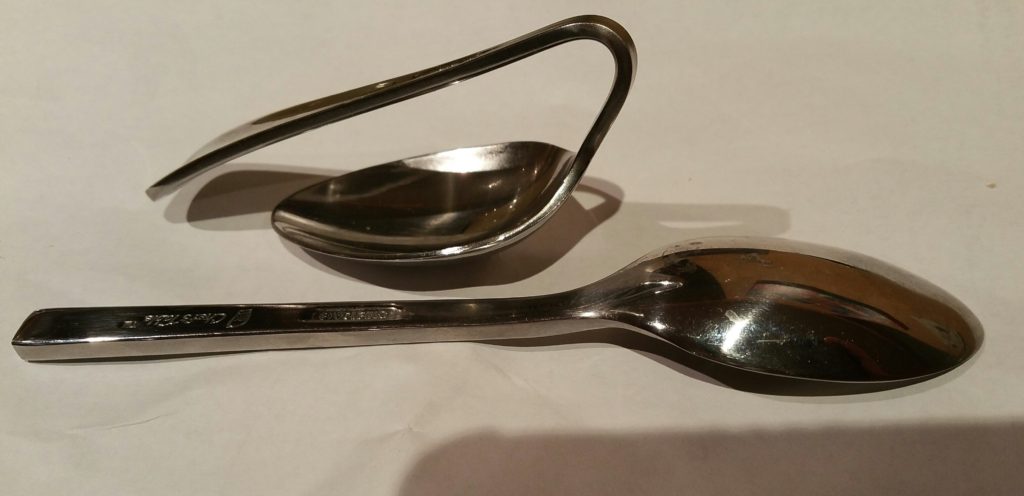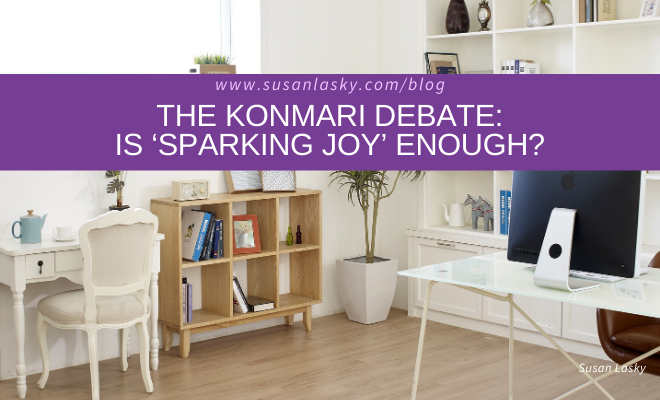
The KonMari Debate: Is ‘Sparking Joy’ Enough?
Most of us want, even long for, a more organized life. A good start is to create a less cluttered home. When we free ourselves from the pressures of excess possessions and over-accumulation, then figure out the best systems for maintaining the stuff we do keep, we open up more than physical space. We gain more time and energy for family, friends, interests, hobbies and experiences.
One of the best ways to get organized is to commit to working at it for a set amount of time on most days – slow and steady may not win the race but it will get stuff accomplished! My online Action-Accountability Group, The TUIT Project, will support your doing just that. You can join the current session or begin next month. www.OvercomeOverwhelm.com
You’ve probably heard of the KonMari phenomenon. If you haven’t, you will (of course you will, I’m mentioning it here!) It is the popularization of Marie Kondo’s method of organizing (‘tidying up’), based on the premise that everything you own should ‘spark joy,’ or let it go. Her message transforms the focus of decluttering and straightening up (tidying) from having to get rid of stuff (loss) to consciously reviewing everything you own and keeping only those items you cherish (gain).
I like this re-frame, but I also have mixed feelings. I’m glad the concept of organizing (and hiring Professional Organizers) is becoming better known through her bestselling book, The Life Changing Magic of Tidying Up: The Japanese Art of Decluttering and Organizing, along with her international publicity and media appearances, her follow-up books (which clarify some of the overly-simplified concepts in her first book), and now her hit Netflix series (which features more relatable homes and families than programs like Hoarders).
I love the positivity and spirituality of Kondo’s message. However, as a Professional Organizer for more than 25 years (and here you thought I was just a Productivity/ADHD coach!), her ‘revolutionary’ ideas have been around for a long time. There are many veteran organizers who have long promoted the benefits of organization from an energy-creating, spiritually uplifting, life-freeing perspective (check out Julie Morgenstern’s classic book, Organizing from the Inside Out), but Kondo’s adorable, single-focused persona and clear method appeals to our deepest desires and makes them seem attainable. Who doesn’t want to ‘spark joy’ (or, as an Old Navy ad puts it, ‘ignite delight!’)? She has been amazingly successful in spreading her message (and it doesn’t hurt to have a marketing/social media guru for a husband and as the CEO of KonMari Media).
During a recent meeting of my local NAPO (the National Association of Productivity and Organizing Professionals) group, we had a somewhat heated discussion about the pros and cons of the KonMari method. It’s a hot topic among organizers everywhere. Here are some opinions from both sides of the debate (I’ve added my comments in brackets with my initials):
Angela Kantarellis, an energetic and very professional organizer, writes in her newsletter about ‘three compelling benefits’:
A powerful brand. “Marie Kondo’s message is simple, clear and consistent. Her brand is positive, light and lovely and she embodies that brand.”
The concept of pure energy. Quoting from Kondo’s book, “One theme underlying my method of tidying is transforming the home into a sacred space, a power spot, filled with pure energy.” Kondo spent 5 years as a Shinto shrine maiden, which has inspired her philosophy. The KonMari method elevates tidying of the home to a spiritual practice. Creating a home filled with pure energy is quite compelling.Joy and gratitude. The process of going through all your worldly possessions one by one is quite an undertaking. Kondo … has infused the KonMari brand with a rigorously positive energy. The tidying process becomes one that is both good for you and indulgent, like a week at a luxurious spa. The hallmark of the KonMari method is asking each object, as you are holding it, if it ‘sparks joy.’ If it doesn’t, out it goes, but before it does, you thank it for its service.
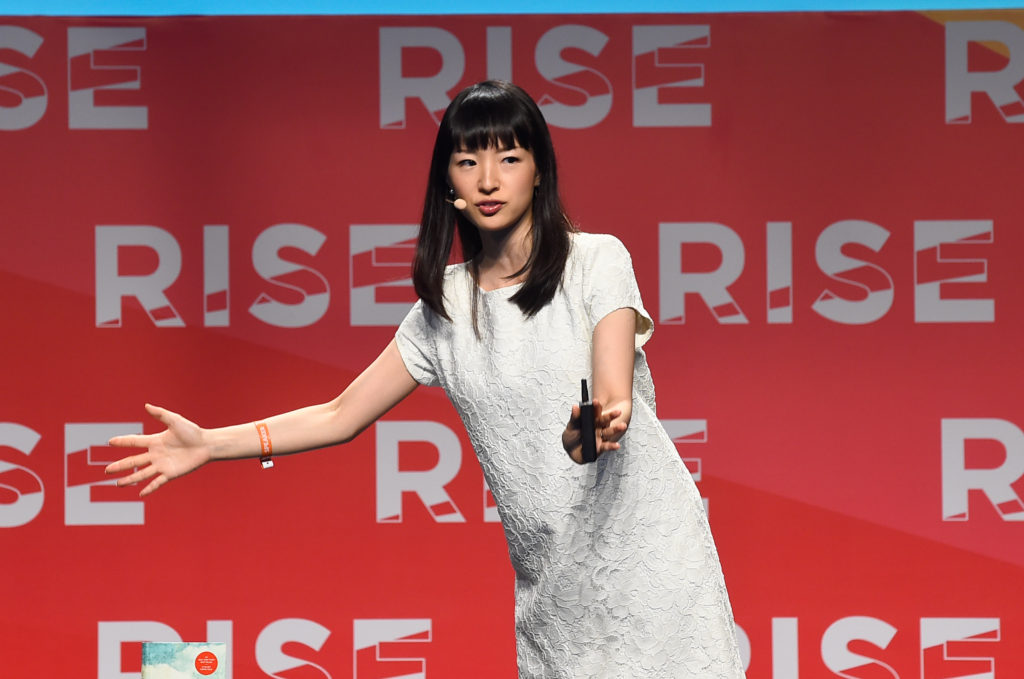
Judith Guertin writes in the ProductiveEnvironmentNetwork.com blog:
“Will you be inspired by watching the (Netflix) show? Perhaps. Will her methods become your methods? Perhaps. Will everything you keep spark joy? I can think of many items I need that do not spark joy in my life! Think about it… the toilet brush… no joy, the broom… no joy, the vacuum cleaner… no joy, the pooper scooper…nooo joy! However, these things are necessary in my life. What I have noticed is that having a clean toilet, clean floor or no pet hair on the furniture is satisfying and makes me feel good, and that is the feeling I am looking for.
[Perhaps feeling good about the benefits of having an item can be the equivalent to ‘sparking joy.’ And, to be fair to Marie K, in an interview in Architectural Digest she says, “Hold them up (your belongings) one by one as you ask yourself, ‘Do I truly need this?’ or ‘Does it spark joy for me?’ Apparently, she’s recently gotten the message to also highlight need; not just joy. –SL]
What I do know is that having a system that you follow every day is the key. Maintenance of the system is critical to staying on track. And, most importantly, having less is something that most, if not all, of us could embrace in our journey to greater joy.”
[When I talk about Organization, I distinguish its components. There’s setting up systems, implementing them, and maintaining them, which is actually Time Management, rather than Organization. You can be great at maintaining systems, but can’t figure out how to set them up, which makes you a perfect candidate for getting an initial boost from a Professional Organizer. I have a talent for designing systems that work, whether for space management or office productivity. But I’m abysmal at maintaining systems, which is why I’ve periodically had the dubious honor of using photos of my office as ‘before’ pictures (which is my trigger to devote time/energy to an office clean-up)! I, like many of my clients, need to budget in clean-up time/maintenance, as it won’t happen on its own. –SL]
“… what Marie Kondo and all Professional Organizers attempt to do is to transfer knowledge and train their clients in systems. Marie’s systems are very clear, and her clients embrace them. I cheer anyone who can make the world a more organized place. What I also know is that her methodology will not work for everyone. Truly, there is no one size fits all answer to getting organized. If you are drawn to her, then you know what to do. If not, there are lots of other equally talented, empathic, non-judgmental Professional Organizers out there. No system is perfect; the one that works for you is the one you subscribe to and use every single day! “
Ramona Creel, a wonderfully opinionated, veteran organizer and author of The Professional Organizer’s Bible, wrote a scathing Facebook post that also makes a lot of sense:
Problem #1 – One Size Does Not Fit All … Anyone who suggests that ‘rolling your socks stresses them out, and they need to be able to rest separately from each other so they can recuperate after the hard work of supporting your feet’ is not functioning in the same plane of reality as the vast majority of my clients.
I’m sort of joking, but this KonMari tip highlights a major problem I have with her approach – that it comes in the form of ‘commandments’ she sincerely believes all humans (regardless of their situation or circumstances) should follow. I’m sorry to inform you, Miss Kondo… that’s not how getting organized works! Just ‘cuz this bizarre set of rules you’ve created helped you ‘tidy up,’ doesn’t mean they’re the answer for anyone else.
[In her Architectural Digest interview, Marie K expands on the sock folding issue by saying, “…What I mean by ‘allowing the socks to rest’ is that the elastic will get stretched over time and will wear out sooner if you roll socks into a ball.” So either she’s gotten the message that most people don’t think socks have feelings, or she didn’t make it clear the first time. I’ve actually folded socks for years, because I can fit more into a drawer (BTW, unlike Marie K, or Ramona, I am not a minimalist – the photo below shows only some of my socks – the rest are still in a giant laundry bag because I don’t make the time to put them away!) –SL]
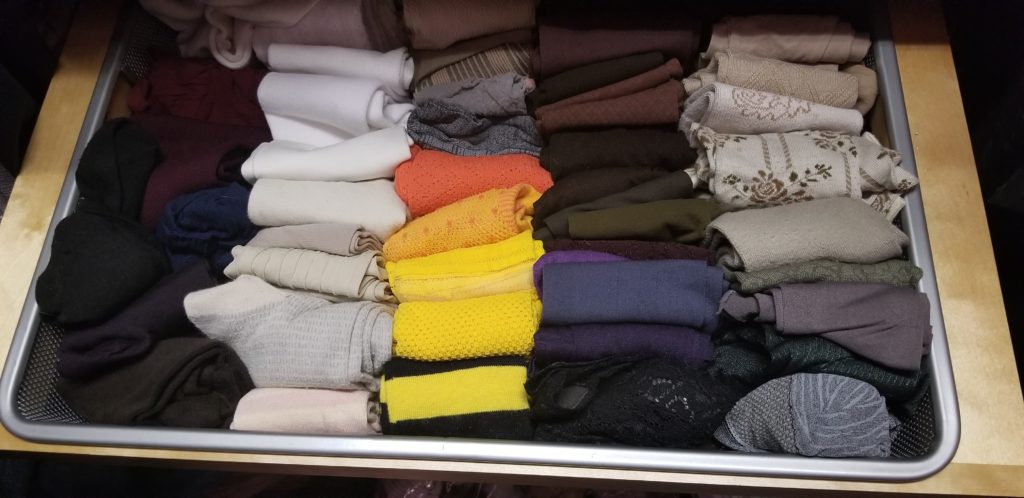
A truly functional and lasting system is tailor-made to align with your lifestyle, way of thinking, habits, proclivities, and personal weird-ities. My work with clients is all about creating customized approaches that suit each individual’s way of living their lives. The KonMari ‘do it my way or you’re doing it wrong’ method is completely antithetical to what Professional Organizing is all about – and it deeply DEEPLY offends my organizational sensibilities. It also leads to my next point…
Problem #2 – Setting Yourself Up for Failure … As I said, the way each person interacts with and thinks about their stuff is unique, different from anyone else on the planet. For any system to perfectly match these quirks, it must also be unique. It’s been proven in our industry time and time again: Cookie cutter solutions are destined to fail for the vast majority of people who try them. So … you end up feeling like you failed and are even MORE daunted by your mess than pre-KonMari.
[For clients with ADHD, executive function or chronic disorganization challenges, any kind of a ‘must do standardized approach’ is particularly problematic. Guidelines are helpful; mandates are not. For some people it’s ridiculous to use a specific number, like Kondo’s ’30’, as the limit for the number of books you keep… or to have only one white t-shirt… or to go through your clothing by putting EVERYTHING you own on the bed at once – that’s easily a trigger for overwhelm and avoidance. Even the concept of touching each item before determining its fate is dangerous to those people for whom physical contact intensifies their ownership/emotional bonds. –SL]
Professional Organizers already struggle daily to help their clients overcome the feeling that they are somehow defective because they can’t stay organized, and this crap doesn’t help any. Plus, it’s not actually teaching clients any useful skills. TRULY understanding an organizing principle (like categorization or containerizing or having a logical reason for where you store things) means you can apply it in a way that suits your needs – and then apply it differently for your spouse, and differently for your kids, and differently for your staff at work. I’m personally about teaching principles that ANYONE can utilize, no matter what their situation, and that ain’t happening here.
[Marie K does (somewhat) address the concept of categorization when she talks about what I’ve always called functional organizing, by saying, “Everything you’d need to write a letter can go in your ‘stationery’ location.” –SL]
The reason REAL Professional Organizers insist on customized systems is so the client can maintain those systems on their own for years to come without the organizer’s help. Attempting to impose someone else’s logic on your stuff, trying to force yourself to become an entirely different person in order to adapt to a system – that’s a recipe for disaster.
[Kondo emphasizes the importance of organizing everything at once, “Organize your space thoroughly, completely, in one go… If your idea of tidying up is to clean up your room a little at a time… it won’t have much effect on your life.” Dramatic transitions are life-changing, but it takes time to get organized. Quick, transformative results are inspiring, but if that’s your organizational goal, you’ll need to put a lot of other things on hold, including any tendencies to get overwhelmed by volume and pressure. Decision-making fatigue is real. Imagine going through everything you own and saying “Yes, sparks joy so I’ll keep it… No, thanks for your service” and donate or discard. I applaud Kondo’s end goal of a life-changing transformation, but how much of that could you take in one sitting (even if over a period of several days), without tuning out completely? –SL]
Problem #3 – She’s Not Saying Anything New …. I also have issues whenever pop culture praises some newcomer for discovering a supposedly ‘innovative’ way of functioning, when all they’re doing is regurgitating what someone else said years and years before them. (I had the same beef with Stephen Covey when he stole Eisenhower’s ‘urgent-vs-important’ matrix and called it his own – betcha didn’t know he did that!)
Even down to her key concept of appreciating the role an item served in your life as a way of allowing yourself to let it go, KonMari isn’t saying anything that I and my colleagues haven’t been preaching for decades. In fact, the mantra I’ve used with my clients for 20+ years (‘beautiful, useful, or loved’) sounds awfully familiar to the concept of ‘sparking joy,’ yet is far older than Miss Marie. It comes from William Morris (head of the Arts and Crafts movement in the 1800s). He and Thoreau and their buddies were helping folks downsize before KonMari existed in even a gonadal state. She’s just saying it in a way the media has latched onto – but she’s dumbed this concept down to the point of that it’s lost all practical application. Which leads me to my next point…
Problem #4 – Over-Simplification … “Does it spark joy?” Well, let’s see. Tax returns don’t spark joy, but they do they keep the IRS off your ass. The lawnmower generally doesn’t spark joy, but it does keep the neighbors from reporting you to the HOA. My toothbrush does not spark any particular sense of joy, but it does keep my teeth in my mouth. I don’t know much of anyone for whom toilet plungers or rectal thermometers or pet-urine-stain-remover especially ‘sparks joy’ – but they come in awfully damned handy when you need them, I would argue that’s a valuable reason to keep something!
I find the concept of sparking joy too simplistic and limiting. I prefer (again) to teach William Morris’s mantra to my clients – is it ‘beautiful, useful, or loved’? That ‘useful’ category is getting the short shrift in KonMari land. Joy-sparkage also doesn’t take into account things like records retention guidelines (how long you’re legally required to keep a document in case of legal problems down the road). Follow KonMari to the letter, and you stand a good chance of ending up in jail!
[OK, this totally makes sense, but it might be an oversimplification of the KonMari approach, especially now that she includes the value of ‘need.’ –SL]
Problem #5 – A Surface Solution at Best … The biggest clutter dilemma my clients face has nothing to do with letting go – it’s the slavish (and often unconscious) need to continue accumulating, even after they’ve cleared the decks. Overcoming that requires an understanding of the psychology behind your particular clutter triggers, because your reasons for accumulating … are very different than anyone else’s. They’re driven by childhood experiences, feelings of loss and lack, the values your family attached to ‘things,’ your ideas about status and success and security. It’s far, FAR more complex an issue.
[Clutter or over-accumulation is more likely when you have ADHD characteristics that include taking on multiple – often unfinished – projects and hobbies… forgetting what you have or where it ‘lives’… getting distracted so not putting things away… impulsively buying things that catch your fancy… getting easily overwhelmed by the details of organizing, cleaning, etc. and going into avoidance mode. For people who are already challenged to put away clean laundry (a common plight faced by many of my clients), the KonMari system of intricately folding tops and socks isn’t going to last beyond the initial fascination stage. There are many wonderful, easy-to-read books that outline organizing strategies that are helpful for the neuro-atypical brain, including ADD-Friendly Ways to Organize Your Life, Organizing Solutions for People with ADHD, The Other Side of Organized and How ADHD Affects Home Organization: Understanding the Role of the 8 Key Executive Functions of the Mind. –SL]
Clutter comes from trying to fill a hole in your life with stuff [and, according to master organizer Barbara Hemphill, ‘postponed decisions.’ – SL ]. Unless you can understand what your particular hole looks like, the piles are just going to come back. To overcome that, you have to understand what drives you accumulate, and your reasons may have exactly zilch to do with joy-sparkage. (I can hand you a million hoarders who desperately love every single piece of trash in their house. If they followed the KonMari method, they’d still be buried in squalor!)
Part of what we Professional Organizers do is more akin to counseling than ‘tidying up.’ We understand how to dig deeper and get at the root of your clutter… how to ask the hard questions that go beyond, “Does it spark joy?”… how to uncover hidden feelings you didn’t even know were bringing extraneous crap into your life. We help you achieve a level of awareness about your beliefs, motivations, and actions that keeps clutter at bay. KonMari’s ‘method’ doesn’t really address this.
[I am concerned that Kondo repeatedly calls her clients ‘lazy.’ She may say it as an incentive to get her clients moving, but for anyone with executive function challenges, depression, anxiety or ADD/ADHD – them’s fighting words! A good P.O. would help a client to get into action, not criticize them for being stuck. Getting going on something (activation or initiation) is a brain-based executive function,which is very compromised when you have any of the above conditions. So please don’t tell me I am what I’m battling not to be– it doesn’t help me to feel encouraged in any way! –SL]
Problem #6 – This Isn’t Organizing … At least she’s honest about what she’s doing in the title of her book – she’s ‘tidying up,’ which any P.O. worth his/her salt will tell you is NOT the same thing as getting organized. I’ve been doing this professionally for more than 20 years, and I can tell you there’s a whole-hell-of-a-lot more to staying organized than cleaning out. That’s just the tip of the iceberg! REAL organization requires a holistic approach, that tackles the clutter in your use of time, your management of information, your ability to prioritize and draw healthy boundaries, your spending, your relationships, your own head. Most of my clients’ organizational knots AIN’T gonna get untangled with an overly-simplified, “Does it spark joy?”
[I’m glad the popularization of the KonMari method has brought lots of attention to the benefits of organizing. There are now Professional Organizers who are certified in this approach, and many others who utilize some of the concepts. The KonMari method has been helpful for many, but it is not appropriate for everyone. While I have read and heard glowing testimonials from people who have tried it, I’m not sure how many of them were dealing with chronic disorganization, executive function issues or ADD/ADHD (although I can see where the clear methodology and set rules can be appealing). –SL]
As you’ve read here, there are very different takes on the KonMari method, with validity for them all. Which side of the debate are you on? Leave your comments below.
Need help to feel more in control of your environment and yourself?
Individual Coaching helps develop strategies and systems that work with the way YOU think. We can also do Virtual Organizing using photos and video. Click here to schedule an Initial Conversation with me. You can also find qualified local Professional Organizers by searching the member listings on NAPO or the ICD (Institute for Challenging Disorganization).
Online Group – One of the best ways to get organized is to commit to working at it for a set amount of time most days. (Marie Kondo, most of us do not have the time or energy to tackle everything at once!) My online Action-Accountability Group, The TUIT Project, will support your doing just that, helping you to actually get around ‘To IT.’ New sessions begin monthly, so sign up now!
Group Coaching – Interested in a video-chat coaching group? Send me an email with the best day and time!

